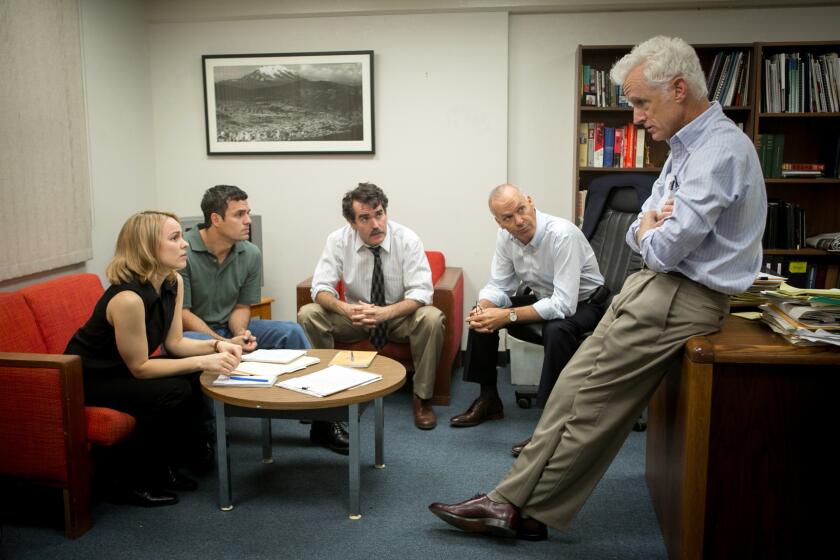Trader Joe’s Bite of the Big Apple Finds a Finicky City’s Sweet Spot
It has all the makings of a trendy Greenwich Village eatery -- exotic foods and serpentine lines.
But the patrons of this Manhattan sensation are as likely to be scooping up Two Buck Chuck (actually, $3 here) as they are New Zealand filet mignon or Harvest Hodgepodge vegetables.
Since opening near Union Square in March, Trader Joe’s has caught the fancy of finicky New Yorkers.
“I walk here from the subway and the people walking the other way are all carrying a couple of these [Trader Joe’s] bags,” said Otto Schmitt, a 71-year-old retired teacher whose weekly pilgrimages require hourlong subway rides from the Bronx.
Though its stores have sprinkled the East Coast for a decade, Union Square marks the Monrovia-based company’s first toehold in New York City.
The 12,600-square-foot market and accompanying 2,787-square-foot wine store are housed on the ground floor of a New York University dormitory, ensuring steady business from the college crowd.
The store features Trader Joe’s trademark tiki-style decor, Hawaiian-shirt-clad employees and shelves primarily stocked with private-label goods. But in a concession to time-pressed New Yorkers, it’s the only Trader Joe’s offering home delivery.
Gothamites have their pick of epicurean specialty stores. But given the high cost of Manhattan living -- $10.75 for a movie ticket and $6 to dry clean a shirt -- Trader Joe’s discount prices count for a lot.
Privately held Trader Joe’s won’t divulge financial information, and company officials declined to be interviewed about their Greenwich Village outpost. But analysts estimate that the store is probably one of the highest grossing in the 256-store chain.
“I imagine it’s way off the charts in sales,” said Neil Currie, a grocery-industry analyst at UBS in New York.
Chainwide, Trader Joe’s sales per square foot are more than twice that of conventional supermarkets, and by all appearances the New York store is thriving, said Len Lewis, author of “The Trader Joe’s Adventure” (Kaplan Publishing, 2005).
“They must be doing a land-office business now that the college students are coming back” from summer vacation, Lewis said. “Just what college kids need: more cheap wine.”
Lewis pegs the company’s annual sales at $2.6 billion or so.
Trader Joe’s was founded by Joe Coulombe as a convenience-store chain in 1958 and began taking on its somewhat Bohemian flavor in 1967, stocking specialty items from around the world such as hummus, soy-based products and an array of unusual snack foods. Wine -- including the Charles Shaw varieties dubbed Two Buck Chuck -- and cheese are also big sellers. Coulombe sold the company in 1979 and left it in 1989, when there were 37 stores, all in California.The New York store pays homage to its city.
A Broadway-style marquee reads “Breadway” and comes replete with faux theater posters of “Oats” (“Cats”) and “The Pita King” (“The Lion King”).
Food tastings are dished out at “Grand Sample Station” and new items are arrayed under the Statue of Liberty.
“It has a New York feel and an L.A. feel,” said Cheryl Zaccagnino, a business consultant who works nearby, referring to the combination of tiki style and Manhattan touches.
Because of a quirk of New York law, Trader Joe’s must run the wine store separately from the main market, and grocery employees are limited in what they can say about it.
On a recent visit, a man asked an employee if the store sold wine. The employee answered, “Not at this location,” and went on to explain her legal constraints in discussing it.
“I can talk about it,” another customer interjected jauntily. “Go out and take a left.”
Perhaps its biggest nod to New York is the checkout line.
It’s often so long that employees take turns holding a tall pennant-shaped sign that reads “Line Ends Here.”
The queue normally snakes from the registers, down the dairy aisle and forms somewhere along the back row. The workers continually pivot their necks to see whether more people have joined the line.
Another worker holds a “6 Items or Fewer” sign.
Given its length, the queue seems to move briskly, and people have adjusted by grabbing milk and yogurt as they wait to check out.
“It’s a whole code,” said Max Chalawsky, a 50-year-old public-school teacher. “Everyone who has gone in here has learned how to do this circle-around” to find the end of the line.
A sign above the cash registers reminds people why they’ve gone to such trouble:
“The Line’s Tiny Compared to the Savings,” it says.
*






